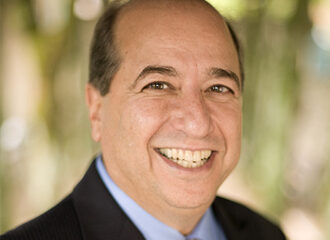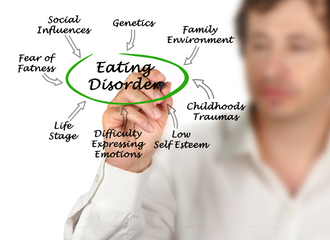Written by: Megan McIntire, LCMHC (she, her, hers)
Professional Relations Manager, The Renfrew Center of Massachusetts
Screening for eating disorders is a complex process. People suffering from an eating disorder don’t always know they have one. Or if they do, they’re not always willing to admit it to a clinician. In this post, we look at how to assess for eating disorders with care.
Eating disorders often hide in plain sight. We live in a culture that normalizes disordered eating behaviors, such as eliminating whole food groups, fasting, and striving for the thin ideal, under the guise of health.
Many programs promise weight loss, or improved health, and prescribe a set of rigid rules, which keep individuals stuck obsessing over calories, weighing themselves, and believing that they have significantly more control over their weight than science deems possible.
Long term research has yet to demonstrate a diet (or to use the euphemism “lifestyle change”) that leads to permanent weight loss. Clients may lose weight at first, only to gain more weight than before they had started, and often with physical and psychological complications from the behaviors they used to get there.
How Eating Disorders Conceal Themselves
Eating disorders may not present as simply a desire to lose weight or look thin. For athletes it may be about reaching peak performance, and for a client struggling with ARFID it may be about fear of vomiting, aversion to food textures, or the uncomfortable sensation of being full.
For others, eating disorders may develop as a response to trauma, and an attempt to control a mood issue, such as anxiety or depression, or as a reaction to food insecurity. Eating disorders can also be an attempt to address gender dysphoria or suppress puberty as a means of birth control.
Why Eating Disorders Are Hard to Screen For
Clients may not understand that there is anything disordered about their behaviors until they are very sick, and it is easy for clinicians to unintentionally collude with the eating disorder, due to unconscious weight bias, or lack of awareness around how eating disorders present. This is dangerous, as eating disorders are among the deadliest mental illnesses, second only to opioid overdose, and are significantly underdiagnosed.
While many clinicians profess not to work with clients who struggle with eating disorders, it’s likely that a client will not report or even be aware that they are presenting with an eating disorder until after the therapeutic relationship has been established. To further complicate the issue, clients who lose weight are often praised by those around them, adding to their buy-in that the eating disorder is positive, rather than a deadly force. Clients who gain weight may experience intense shame and criticism, in some instances from clinical professionals.
To adequately assess for eating disorders we must be aware of these possible barriers, screen carefully, and challenge our own biases.
3 Essential Guidelines for Screening for Eating Disorders
1. Screen early and often
Coping behaviors such as skipping a meal to lose a few pounds before bikini season, or stress eating due to a challenging work situation can be a slippery slope into disordered eating, and if they become habits, can easily become an eating disorder.
Adding assessment tools such as the Eating Disorder Examination Questionnaire (EDE-Q); Eating Disorder Inventory 3 (EDI-3), or Eating Disorder Diagnostic Scale (EDDS), to your rotation, can invite clients to share behaviors of concern. We can also do “soft” assessments, such as asking about mealtimes, exercise routines, body image concerns, food insecurity, and family dynamics that may add stress to mealtimes, or pressures to lose weight.
Continuing to keep these aspects of a client’s life in mind during session will help us pick up cues of possible disordered eating, or disordered thinking around food, exercise, body image, and self-worth.
2. Know the risk factors and co-occurring issues
Eating disorder behaviors are often attempts to address emotional dysregulation. Over 94% of clients who have eating disorders have co-occurring anxiety, depression, OCD, or PTSD. Clients learn fast that behaviors such as restricting, binging, purging and/or over exercising are very effective at shifting one’s mood (in the short term).
Not surprisingly, clients who self-harm in other ways, abuse substances, and/or have a trauma history are at greater risk of developing an eating disorder. Clients may not recognize how their behaviors are being used as emotional avoidance strategies and attempts to manage both their weight, as well as their mood.
Studies show that not only are clients who are marginalized more likely to develop an eating disorder, they are also significantly less likely to be diagnosed.
Social discrimination, parental rejection, peer victimization, and internalized stigma are all contributing factors. Seeing through this lens may help us broaden our scope, knowing it is not only clients who have weight fluctuations or express body image concerns who are at significant risk of having an eating disorder.
3. Be aware of your biases and stay in your lane
If a client presents having lost weight in a short amount of time, rather than automatically rejoicing with the client, take a moment to pause and consider what might have led to this “victory”.
We live in a culture that unequivocally praises thinness. Even professionals may fall prey to this thinking. This is especially dangerous, as it may reinforce disordered eating behaviors. Rather than praising weight shifts, this is an opportunity to stay in your lane, and refer them to a registered dietitian, and recommend they follow up with their PCP, as weight shifts can be a sign of eating disorders, as well as other serious health issues.
You can use the tools at Project Implicit to check your own biases around weight, exercise, and health. Consider the message your office space sends to clients, such as having furniture that is comfortable to clients in all body sizes and making sure that your magazine collection does not promote diet culture.
4. Conclusion
Eating disorders can be difficult to spot, are often undiagnosed, or present in clients you may not suspect. Even if you don’t advertise that you work with clients who struggle with eating disorders, it is likely that clients who show up in your practice may still struggle. If you’re unsure whether your client is struggling with an eating disorder, The Renfrew Center can help by providing free consultation with one of our Clinical Assessors, or to assist your client in scheduling an eating disorder assessment. Renfrew offers free screening tools for clients, as well as support and information for loved ones, on how to help.




